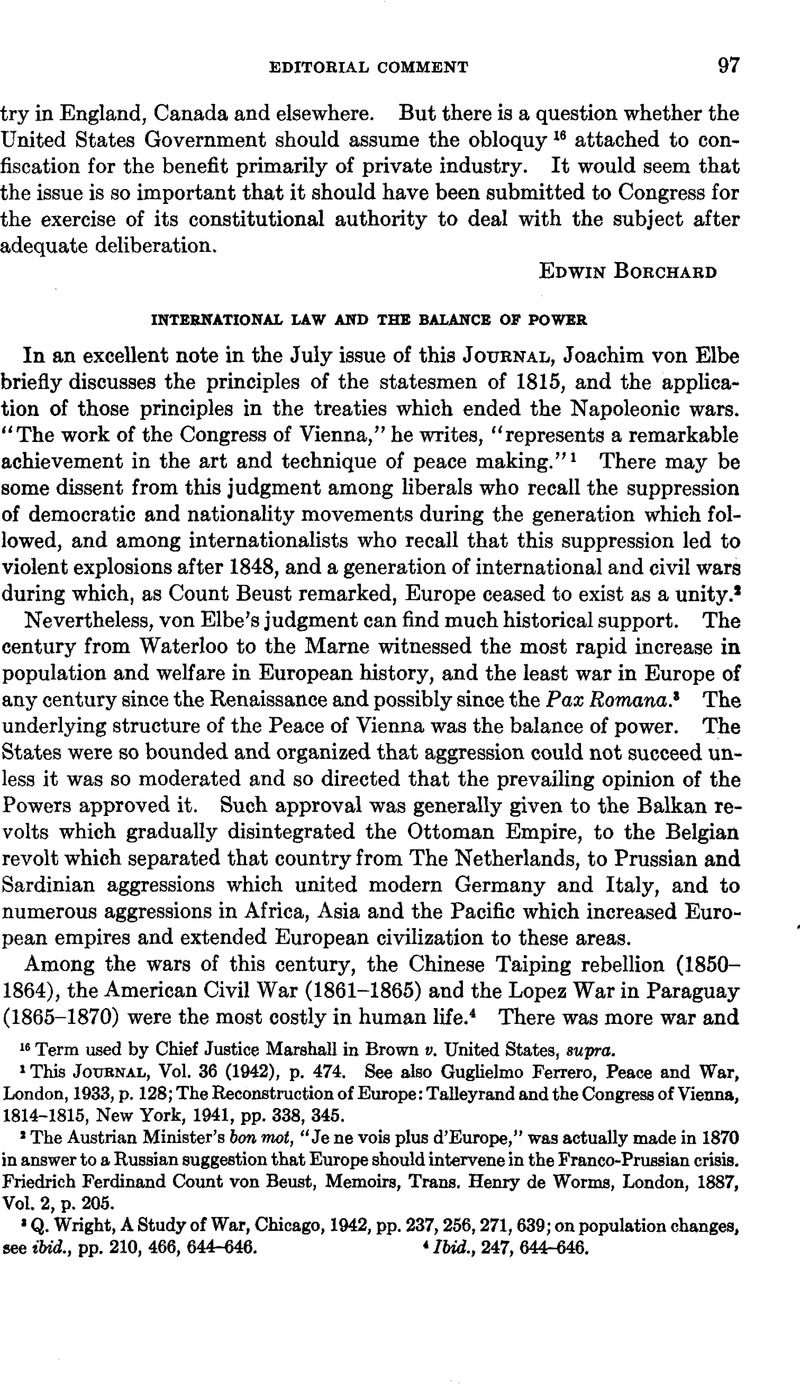Article contents
International Law and the Balance of Power
Published online by Cambridge University Press: 12 April 2017
Abstract

- Type
- Editorial Comment
- Information
- Copyright
- Copyright, 1943, by the American Society of International Law
References
1 This Journal, Vol. 36 (1942), p. 474. See also Ferrero, Guglielmo, Peace and War, London, 1933, p. 128 Google Scholar; The Reconstruction of Europe: Talleyrand and the Congress of Vienna, 1814–1815, New York, 1941, pp. 338, 345.
2 The Austrian Minister’s bon mot, “Je ne vois plus d’Europe,” was actually made in 1870 in answer to a Russian suggestion that Europe should intervene in the Franco-Prussian crisis. Friedrich Ferdinand Count von Beust, Memoirs, Trans. Henry de Worms, London, 1887, Vol. 2, p. 205.
3 Wright, Q., A Study of War, Chicago, 1942, pp. 237, 256, 271, 639Google Scholar; on population changes, see ibid., pp. 210, 466, 644–646.
4 Ibid., 247, 644–646.
5 In addition to the Taiping, American Civil and Lopez ware, in each of which the war deaths were over 600,000, there were six wars during the period in which such losses were from 100,000 to 200,000 (Crimean, 1854–1856; Italian, 1859; Franco-Prussian, 1870–1871; Russo-Turkish, 1878–1879; Russo-Japanese, 1904–1905; and Balkan, 1912–1913), and three wars in which such losses were from 30,000 to 60,000 (Russo-Turkish, 1828–1829; Austro-Prussian, 1866; and South African, 1899–1901). Of these twelve most serious wars, two were fought in the Americas, one in Africa, two in the Far East, four in the Near East and three in Western and Central Europe. Of a total of 87 wars during this period, 17 were fought in North and Middle America, 10 in South America, 7 in South and Central Africa, 8 in the Far East, 8 in the Middle East, 20 in the Near East, and 17 in Western and Central Europe. See Q. Wright, op. cit., pp. 644–646; Dumas, Samuel and Vedel-Petersen, K. O., Losses of Life Caused by War, London, 1923, pp. 40–59 Google Scholar.
6 Q. Wright, op. cit., pp. 599, 612.
7 Spykman, Nicholas J., American Strategy in World Politics, New York, 1942 Google Scholar; Wolfers, Arnold, “Anglo-American Post War Coöperation and the Interests of Europe,” American Political Science Review, August, 1942, Vol. 36, p. 665 CrossRefGoogle Scholar; Ferrero, Guglielmo, The Principles of Power: the Great Political Crises of History, New York, 1942.Google Scholar
8 H. W. Briggs questions whether international law can succeed if it consists of a “series of prohibitions against the power politics of states” (this Journal, Vol. 36 (1942), p. 639). Edwin Borchard, believing that “law plays only a minor part in international social control” and that the national state is likely to remain for some time, “the unit of the international constellation,” doubts whether “community or group force” can be substituted in place of “nation-force” (ibid., pp. 629–630). Philip Marshall Brown, on the other hand, objects to those who “contemn the law of nations as something negligible.” He attributes this attitude to the positivistic tendency which puts treaty law ahead of custom but he! eaves some doubt as to the relation of the two when he writes: “With very rare exceptions… treaties do not create international law, but confirm and register established usage. Treaty-made law necessarily represents diplomatic compromises and frequently reveals gross inconsistencies with accepted usage.” (Ibid., p. 634.) Clyde Eagleton assumes that the future of international law can only be foreseen by studying the relation of changing technical, social and economic conditions to permanent human interests. (Ibid., pp. 640–643.) Briggs expresses a similar idea though, like Borchard, he appears to assume that traditional power politics can not be controlled by law. In this he differs from Elihu Root, “The Outlook for International Law,” Proc. Am. Soc. Int. Law, 1915, p. 2 ff.
9 Q. Wright, op. cit., pp. 341–346, 351–356, 891–894. On the influence of changing conditions upon state policies see ibid., 1255–1260 and upon international law see ibid., pp. 907, 922, 975–986.
10 Ibid., op. cit., pp. 743 ff., 935–939, 1022.
11 Ibid., pp. 364–371.
12 These tendencies can be traced back to the Renaissance period, but they became much more important during the 19th century. Ibid., pp. 166–167, 204–212, 303–313, 612–614.
13 Ibid., pp. 765–766, 859–860.
14 Ibid., pp. 298–299; Wright, Q., “The present status of neutrality,” this Journal, Vol. 34 (1940), pp. 413–414 Google Scholar.
15 Spykman, op. cit., pp. 468–472.
16 Root, Elihu, “The Efiect of Democracy on International Law,” Proc. Am. Soc. Int. Law, 1917, pp. 7, 9.Google Scholar
17 Wright, Q., A Study of War, pp. 262–269 Google Scholar.
18 Wright, Q., A Study of War, pp. 281–285, 307–310, 317–319, 1168–1172.Google Scholar
19 Ibid., pp. 237–242, 647–650.
- 4
- Cited by


